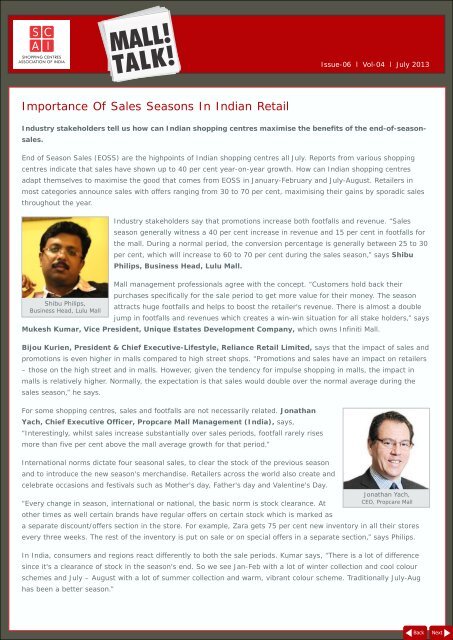S CA I<strong>Issue</strong>-0 6 l Vol-04 l <strong>July</strong> 2<strong>01</strong>3Importance Of Sales Seasons In Indian RetailIndustry stakeholders tell us how can Indian shopp<strong>in</strong>g centres maximise the benefits of the end-of-seasonsales.End of Season Sales (EOSS) are the highpo<strong>in</strong>ts of Indian shopp<strong>in</strong>g centres all <strong>July</strong>. Reports from various shopp<strong>in</strong>gcentres <strong>in</strong>dicate that sales have shown up to 40 per cent year-on-year growth. How can Indian shopp<strong>in</strong>g centresadapt themselves to maximise the good that comes from EOSS <strong>in</strong> January-February and <strong>July</strong>-August. Retailers <strong>in</strong>most categories announce sales with offers rang<strong>in</strong>g from 30 to 70 per cent, maximis<strong>in</strong>g their ga<strong>in</strong>s by sporadic salesthroughout the year.Shibu Philips,Bus<strong>in</strong>ess Head, Lulu <strong>Mall</strong>Industry stakeholders say that promotions <strong>in</strong>crease both footfalls and revenue. “Salesseason generally witness a 40 per cent <strong>in</strong>crease <strong>in</strong> revenue and 15 per cent <strong>in</strong> footfalls forthe mall. Dur<strong>in</strong>g a normal period, the conversion percentage is generally between 25 to 30per cent, which will <strong>in</strong>crease to 60 to 70 per cent dur<strong>in</strong>g the sales season,” says ShibuPhilips, Bus<strong>in</strong>ess Head, Lulu <strong>Mall</strong>.<strong>Mall</strong> management professionals agree with the concept. “Customers hold back theirpurchases specifically for the sale period to get more value for their money. The seasonattracts huge footfalls and helps to boost the retailer's revenue. There is almost a doublejump <strong>in</strong> footfalls and revenues which creates a w<strong>in</strong>-w<strong>in</strong> situation for all stake holders,” saysMukesh Kumar, Vice President, Unique Estates Development Company, which owns Inf<strong>in</strong>iti <strong>Mall</strong>.Bijou Kurien, President & Chief Executive-Lifestyle, Reliance Retail Limited, says that the impact of sales andpromotions is even higher <strong>in</strong> malls compared to high street shops. “Promotions and sales have an impact on retailers– those on the high street and <strong>in</strong> malls. However, given the tendency for impulse shopp<strong>in</strong>g <strong>in</strong> malls, the impact <strong>in</strong>malls is relatively higher. Normally, the expectation is that sales would double over the normal average dur<strong>in</strong>g thesales season,” he says.For some shopp<strong>in</strong>g centres, sales and footfalls are not necessarily related. JonathanYach, Chief Executive Officer, Propcare <strong>Mall</strong> Management (India), says,“Interest<strong>in</strong>gly, whilst sales <strong>in</strong>crease substantially over sales periods, footfall rarely risesmore than five per cent above the mall average growth for that period.”International norms dictate four seasonal sales, to clear the stock of the previous seasonand to <strong>in</strong>troduce the new season's merchandise. Retailers across the world also create andcelebrate occasions and festivals such as Mother's day, Father's day and Valent<strong>in</strong>e's Day.“Every change <strong>in</strong> season, <strong>in</strong>ternational or national, the basic norm is stock clearance. Atother times as well certa<strong>in</strong> brands have regular offers on certa<strong>in</strong> stock which is marked asa separate discount/offers section <strong>in</strong> the store. For example, Zara gets 75 per cent new <strong>in</strong>ventory <strong>in</strong> all their storesevery three weeks. The rest of the <strong>in</strong>ventory is put on sale or on special offers <strong>in</strong> a separate section,” says Philips.In India, consumers and regions react differently to both the sale periods. Kumar says, “There is a lot of differences<strong>in</strong>ce it's a clearance of stock <strong>in</strong> the season's end. So we see Jan-Feb with a lot of w<strong>in</strong>ter collection and cool colourschemes and <strong>July</strong> – August with a lot of summer collection and warm, vibrant colour scheme. Traditionally <strong>July</strong>-Aughas been a better season.”Jonathan Yach,CEO, Propcare <strong>Mall</strong>BackNext
S CA I<strong>Issue</strong>-06 l Vol-04 l <strong>July</strong> 2<strong>01</strong>3Mukesh Kumar,Vice President, Unique EstatesDevelopment Companylooked upon market<strong>in</strong>g activity,” says Philips.Kumar says that the world economic downturn has not impacted the fashion conscious whocont<strong>in</strong>ue to shop, on the back of disposable <strong>in</strong>come. However, Kurien says that the globaleconomic downturn has seen <strong>in</strong>creased promotional activities. “The tendency to go on salehas only <strong>in</strong>creased due to the past and current slowdown that we are witness<strong>in</strong>g. Whilethis temporarily helps to <strong>in</strong>crease sales, it is not susta<strong>in</strong>able <strong>in</strong> the long term,” he says.In some markets, the downturn has resulted <strong>in</strong> structured, long term changes. “The onlychange witnessed dur<strong>in</strong>g the recession <strong>in</strong> 2009-2<strong>01</strong>0 is that the sale period was extendedby retailers to a 45-day period <strong>in</strong>stead of the normal 20-30 days. Another noticeablechange that has been observed is that certa<strong>in</strong> brands are now manufactur<strong>in</strong>g specificallyfor the sale period. Instead of just be<strong>in</strong>g a stock clearance activity, sales are now a muchFor sales and <strong>in</strong>deed the shopp<strong>in</strong>g centres to be susta<strong>in</strong>able, stakeholders need to work <strong>in</strong> cohesion. For malls thathave a revenue share models, there are various comb<strong>in</strong>ations that suit both parties. “When sales rise, revenue share<strong>in</strong> that month rises too,” says Yach.But, even who don't work on shared revenues, there is much to do. Kumar says, “As a mall we do loads of market<strong>in</strong>g<strong>in</strong>itiatives to encourage our tenants dur<strong>in</strong>g their sale season. We plan a Flat 50 Per Cent off day <strong>in</strong> which more than100 brands participate. We extend ourselves and promote this day so that it helps <strong>in</strong> boost<strong>in</strong>g the sale of the retailersand exert a pull on footfalls to the mall. Our market<strong>in</strong>g campaign runs through pr<strong>in</strong>t ads, radio, outdoor hoard<strong>in</strong>gs,social media and onl<strong>in</strong>e forums and <strong>in</strong> mall communications.”Given that sales seem to driv<strong>in</strong>g revenues – reports <strong>in</strong>dicate that sales have zoomed up 40 per cent Year On Yeargrowth – is it not <strong>in</strong> the <strong>in</strong>terest of the mall management to encourage them?Philips tells us that the norm is that at the time of sign<strong>in</strong>g the revenue share deal itself, a lesser percentage is agreedupon as the revenue share dur<strong>in</strong>g the sales period. However, he says, “In case of revenue share as well, an <strong>in</strong>creaseof 40 per cent is seen <strong>in</strong> the revenue dur<strong>in</strong>g sales.”In fact, retailers <strong>in</strong> shopp<strong>in</strong>g centres, with revenue share models, have worked out for the benefit of both parties.They have it better than the high street retailers who are bear<strong>in</strong>g the brunt of soar<strong>in</strong>g rentals <strong>in</strong> tier-I cities.Kumar po<strong>in</strong>ts out, “We do not operate on revenue shar<strong>in</strong>g model. But, generally, on a revenue shar<strong>in</strong>g model theprofits are marg<strong>in</strong>al dur<strong>in</strong>g the sales season. However, it generates huge turnover and also clears the dead stock.Revenues go up dur<strong>in</strong>g the sale season giv<strong>in</strong>g more share to the developers.”Most shopp<strong>in</strong>g centres see the benefits of EOSS. Kurien says, “<strong>Mall</strong>s can do a lot to supportthe sales periods of retail stores. Orchestrat<strong>in</strong>g the sell<strong>in</strong>g seasons, ensur<strong>in</strong>g that retailerswith<strong>in</strong> categories complement each other, optimis<strong>in</strong>g the sales schemes of differentretailers to prolong the overall sales season,” are some of the measures he lists, along with“freebies thrown <strong>in</strong> by the malls such as lucky draws, coupon schemes.”Philips gives an example of Lulu <strong>Mall</strong> and shopp<strong>in</strong>g centres. He says, “Most mallsorchestrate a complete event out of the sales period. Some malls do one day off, some flat50 per cent off and there have been cases of the stores be<strong>in</strong>g able to do the whole month'ssales <strong>in</strong> a s<strong>in</strong>gle day. Other malls do extended events with shop and w<strong>in</strong> contests andother enterta<strong>in</strong>ment activities to cajole customers <strong>in</strong>to shopp<strong>in</strong>g more. At Lulu <strong>Mall</strong> itself,we are comb<strong>in</strong><strong>in</strong>g the salesBijou Kurien,President & Chief ExecutiveLifestyle, Reliance Retail LimitedBackNext





